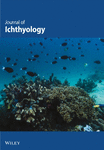Maturity and gonad changes of Oreochromis (Nyasalapia) karongae raised in fish ponds in Malawi
Abstract
The reproductive biology of pond-raised Oreochromis (Nyasalapia) karongae was investigated. Gonad histology and gonadosomatic indices (GSIs) indicated a potential for multiple spawning in a season. Several peaks of oocyte-size distribution and several maturation stages occurred in the same gonad. GSIs of 2.5% and 1.4% were recorded in female and male fish, respectively. Three stages of oocyte maturation (primary growth, formation of yolk vesicles, vitellogenesis) and three stages of sperm development (spermatogonia, spermatid, spermatozoa) were observed. With the exception of the final maturation stage, all development phases seemed to proceed satisfactorily. The final stage of maturation was attained at oocyte size of 2.70 ± 0.54 mm and was selectively impaired in some female fish by a lack of deposition of vitellogenin. This abnormal condition led to atrophic oocytes lacking yolk granules and vesicles. Sexual maturation was attained at a relatively large size of 16.0 cm (114 g) compared with other tilapia of the mossambicoid group (i.e. Oreochromis mossambicus and Oreochromis shiranus). A combination of gravimetric and histological techniques was successful in charting gonad changes and calibrating external against internal gonad features.




